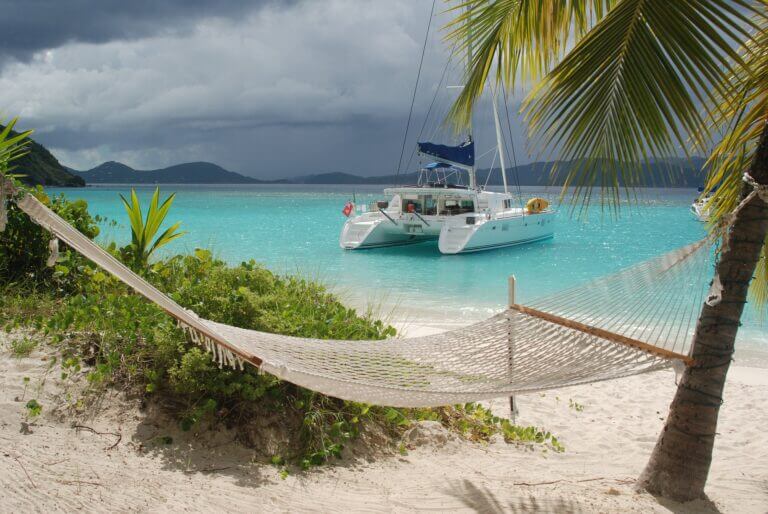What is a Ketch Sailboat?
Ketch boats are frequently seen in certain regions and offer various advantages in terms of handling. However, what is a ketch and how does it stand out?
A ketch is a sailboat with two masts. The mainmast is shorter than the mast on a sloop, and the mizzenmast aft is shorter than the mainmast.
Ketches are a type of sailing vessel that have been around for centuries. They are known for their unique design, which features two masts – the main mast located towards the front of the vessel and a smaller mizzen mast located towards the back.
Understanding the Definition of a Ketch
Ketch rig is a type of sailboat that has two masts, with the main mast located forward and the smaller mizzen mast positioned aft. The ketch rig offers a variety of sail combinations to be used depending on wind conditions, making it one of the most versatile rigs available. The ketch rig allows for easy handling in all weather conditions, and its balance makes it ideal for long-distance cruising and offshore sailing.
The versatility of the ketch rig lies in its ability to use different sail combinations. For example, when sailing upwind or close-hauled, the mainsail and jib are typically used. When reaching or running downwind, the mizzen sail can be added to increase speed and stability. This flexibility allows sailors to adjust their sails according to changing weather conditions.
The ketch rig also offers excellent balance due to its two-mast configuration. The smaller mizzen mast positioned aft helps balance out the larger main mast located forward, providing increased stability in rough seas. This balance makes it easier for sailors to handle their boats in challenging conditions.
Ketches and Yawls: Understanding the Difference
Mizzen Mast Position: The Main Difference
The primary difference between a ketch and a yawl is the position of the mizzen mast. In a ketch, the mizzen mast is located forward of the rudder post, while in a yawl, it is located aft of the rudder post. This difference in placement has several implications for how each type of sailboat rig handles on the water.
Larger and More Sail Area
Ketches are typically larger than yawls and have more sail area. This extra sail area allows them to generate more power and speed when sailing downwind or reaching. Ketches also tend to be heavier than yawls, which makes them more stable in rough seas. However, this added weight can make them slower to accelerate and maneuver in tight spaces.

Technical Analysis: Comparing Ketch vs Yawl Rigs
When comparing ketch vs yawl rigs from a technical standpoint, there are several factors to consider beyond just their size and sail area. One important consideration is the center of effort, which is the point where all the forces generated by the sails converge. In a ketch rig, the center of effort is typically farther forward than in a yawl rig, which can make it more difficult to balance when sailing upwind.
Another factor to consider is how each type of rig handles in different wind conditions. Ketches tend to perform better in light winds because they have more sail area to catch any available breeze. However, as the wind picks up, their heavier weight and larger size can make them more difficult to handle. Yawls, on the other hand, are better suited for heavy weather because their smaller size and aft-mast position give them better balance and control.
Variations of Ketch Sailboats
Although not frequently seen, the ketch is a type of sailboat that catches one’s attention due to its unique features. They are known for their classic design, spacious interiors, and comfortable cruising capabilities. These boats have been used for centuries as working watercraft, particularly in fishing and cargo transport, due to their ability to carry large loads and navigate in shallow waters. Here are some variations of ketch sailboats that you should know about.
Traditional Ketch Rig
The traditional ketch rig is characterized by having two masts, with the smaller mizzen mast located aft of the main mast. This rig has a triangular mainsail and a quadrilateral mizzen sail. The mainsail is usually larger than the mizzen sail, which provides balance and stability to the boat. This type of rig is commonly found on older sailing vessels.
Schooner-Rigged Ketch
The schooner-rigged ketch features two or more headsails instead of just one like other types of ketches. This rig allows for greater flexibility in adjusting sails according to wind conditions. It also gives the boat more speed when sailing downwind.
Gaff-Rigged Ketch
The gaff-rigged ketch features a gaff rig on both the main and mizzen masts. The sails are typically made of canvas, which gives them a classic look. This type of rig is often found on traditional wooden boats.
The Origin of the Word Ketch
Etymology is a fascinating field that allows us to trace the origins and evolution of words. The word “ketch” is no exception, with its roots dating back to Middle English. In this section, we will delve deeper into the history of the word “ketch” and explore how it came to be associated with a particular type of vessel.
The Middle English Connection
To understand the origin of the word “ketch,” we need to look at its linguistic roots. The word is believed to have originated from the Middle English word “cacchen,” which means “to catch.” This connection makes sense when you consider that ketches were originally designed for fishing purposes.
Samuel Pepys’ Diary
The first recorded use of the word “ketch” was in 1667 in Samuel Pepys’ diary. Pepys described a small two-masted vessel as a “ketch,” providing us with an early example of how the term was used in context. It’s interesting to note that even in Pepys’ time, ketches were already being used for both commercial and recreational purposes.

Ketches: A Historical Overview
17th Century Origins
In the 17th century, ketches were developed as a response to the need for more efficient and versatile sailing vessels. The design of ketches allowed them to carry more cargo and sail faster than other types of ships at the time. With their two masts, ketches were able to accommodate a larger sail area while still being easy to handle with a smaller crew.
The early ketch designs were primarily used for fishing and trading, as they could easily navigate shallow waters and enter ports that larger ships could not. Their ability to sail close to the wind made them ideal for coastal trading routes.
Golden Age of Piracy
During the Golden Age of Piracy in the 18th century, ketches became popular among pirates due to their versatility and speed. Pirates would use ketches for raiding other ships, as well as transporting stolen goods back to their hideouts.
One notable example is the infamous pirate Blackbeard’s ship, Queen Anne’s Revenge. This ship was originally built as a French slave ship but was later captured by Blackbeard and converted into a powerful ketch with 40 guns.
Decline in Popularity
As steam-powered ships began to rise in popularity in the 19th century, traditional sailing vessels like ketches began to decline in use. However, they continued to be used for coastal trading and fishing due to their ability to navigate shallow waters and small harbors.
Resurgence in Popularity
In the 20th century, there was a resurgence in popularity among recreational sailors due to their ease of handling and versatility. Ketch designs were modified with modern materials such as fiberglass hulls and aluminum masts which made them easier and cheaper to build. Today, a few modern sailboat designs are based on traditional ketch designs.
Benefits of Ketches
The ketch rig offers several advantages over larger sloops.
FAQs
What is the purpose of a ketch?
A ketch sailboat is designed to provide better balance and control than other types of sailboats. It has two masts, with the larger main mast located towards the front and a smaller mizzen mast towards the back. This configuration allows for greater sail area and better maneuverability, making it easier to handle in challenging conditions.
Can one person sail a ketch?
It is possible for one person to sail a ketch, but it depends on the size and complexity of the boat. Smaller ketch sailboats can be handled by a single sailor with some experience, but larger vessels will require a crew or advanced sailing skills.
What is the largest sailing ketch in the world?
The largest sailing ketch in the world is currently the 107-meter “Black Pearl,” which was launched in 2018. The Black Pearl is a hybrid sailing yacht that features a combination of sail and diesel-electric propulsion, making it one of the most technologically advanced and luxurious ketches in the world.
What is a 3-masted sailboat called?
A 3-masted sailboat is typically called a schooner if it has two or more fore-and-aft rigged masts, or a barquentine if it has a square-rigged sail on the foremast and fore-and-aft sails on the other masts.
Can you sail a ketch without the Mizzen?
Yes, it is possible to sail a ketch without the mizzen sail, but it may affect the balance and maneuverability of the boat. In general, it is recommended to use all sails on a ketch to achieve the best performance and control. However, in certain conditions, such as high winds, it may be necessary to reduce sail area by taking down the mizzen or other sails.
What are some popular ketch sailboat models?
Some popular ketch sailboat models include the Amel Maramu, the Hallberg-Rassy 43, and the Tayana 37.







